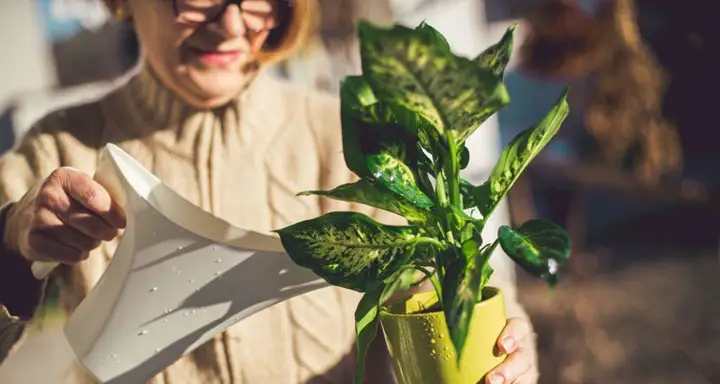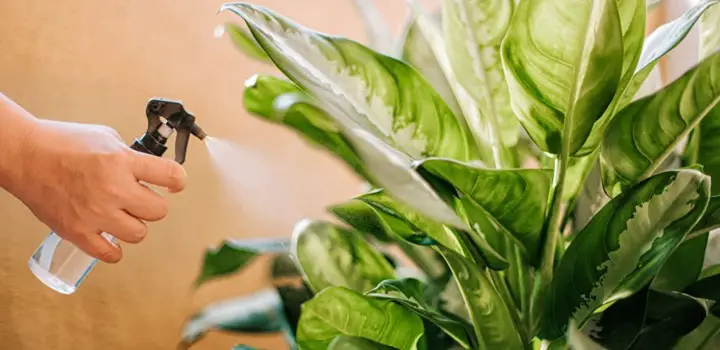Dieffenbachia or dumb cane is a tropical plant native to Mexico. Because of its adaptability in indirect light, it has been a good pick for home growers. Besides, the bright mottled leaves are always a feast for the eyes.
However, most of the time, like the other houseplants, dieffenbachia suffers in unfavorable conditions. Mostly the leaves are affected in these cases.
Droopy and wilted leaves are common issues to talk about. In today’s article, I am going to highlight some aspects like improper watering, pest infestation, bacterial attack, low humidity, excess fertilizer, and sunlight with proper treatment on this. If you are dealing with similar issues, you might find a fix here.
So let’s get started without further ado.
What Causes Droopy Leaves in Dieffenbachia -Problems and Fixes

1. Improper Watering Schedule
A wrong watering pattern can gradually affect your plant vigor. Most of the houseplants are quite susceptible to watering. The prominent symptoms start with curling leaf edges and yellowing.
Both excess and deficit watering can cause wilting and drooping of leaves. So, it’s important to have an idea of when and how much water is needed for your dieffenbachia.
However, watering once in 7 days is enough depending on your plant size. You must avoid implying everyday watering as it also causes droopy leaves by eliminating air pockets from the soil.
Control Measure
Soil observation is necessary to check either watering is needed or not. This can be checked by touching the upper surface of the soil or using a moisture meter (Our pick: Atree Soil Soil Tester Kits with Moisture, Light, and PH Test for Garden).
You may also need to dig up a bit to check how much water is needed. Generally, dry soil up to a level of 1 inch beneath the surface is a clear indication of water scarcity. So, it’s the time you need to water your dieffenbachia.
As I have mentioned before, you may need to water your dieffenbachia once a week. But you may need to water more often if the weather is too hot. Remember to water again whenever the soil is almost dry.
Sometimes droopy leaves may not be recovered if permanent wilting occurs. So it’s better to trim them off then.
If you have overwatered your plant accidentally, clean the drainage hole to pass off the excess water.
2. Pest Infestation
Pest is the main destroyer of your houseplants. Droopy leaves in dieffenbachia can also be caused by pest attacks.
Normally, sucking and burrowing insects and beetles suck up the cell sap which causes leaf wilting in plants. Houseplants are more susceptible to such pest attacks. The most common insect pests associated with droopy leaves in dieffenbachia are aphids, spider mites, and scale insects.
How to trace pests in your dieffenbachia?
Honeydew on the leaf surface can indicate the presence of the little sucking aphids. You can spot others by observing leaf spots or whole insects.
Control Measure
At the early stage of infestation, handpicking is an easy way to remove such pests. Just look for insect mass or their eggs and remove them immediately. Similarly, water splashes are effective in washing off pests.
You can also place some sticky traps with bright yellow or blue sheets around your plant to trap the minute flyers.
To treat a severe infestation, you may need some chemicals. You can pick any pesticide containing horticultural oil. A concentration of 2% oil is the most effective. So you can use this one (Our Pick: Natria 706240A Neem Oil Concentrate Pest Control)
Home Remedies
I can suggest to you some home remedies which are considered to be effective yet mild to houseplants. So, let’s take a look.
#Recipe 1: Soap Spray
Ingredients:
- 6 teaspoons of castile soap
- 4 liters of water
Steps:
- Mix castile soap in water
- Transfer this mixture into a spray bottle
- Apply this to the plant leaves on the infected area
Caution: Avoid using soaps having higher leach content as these can be harsh to your foliage.
#Recipe 2: Garlic Spray
Ingredients:
- 2 whole garlic bulbs
- One tablespoon of vegetable oil
- 500 ml of water
Steps:
- Grind garlic to make a paste and add vegetable oil to this
- Then add the water to it and strain.
- Use the liquid extract as a spray for your dieffenbachia
3. Bacteria
Bacteria attack plant roots and block the water-conducting tissues. This hampers the water supply to the overall plant.
Droopy leaves are a common sign of wilting and most of the wilts in plants are caused by bacteria. If you can’t trace where you are making mistake, bacteria can be the culprit here.
Dull to yellow leaves is the early symptom of droopy leaves in dieffenbachia. The droopiness can start from the leaf veins.
Another wise practice to detect bacterial attacks is soaking plant stems in water. You can notice bacterial ooze coming out of the stem easily by this.
So, you can easily identify the bacterial attack in your plant. Now let’s check now how can you combat such issues.
Preventive Measure
It’s a bit tricky to control bacterial wilting which causes droopy leaves in dieffenbachia. The best you can do is to adopt some precautionary measures.
You have to maintain proper hygiene in your houseplants. Remove diseases plant parts as soon as possible and do not forget to sterilize the garden equipment. Rubbing alcohol or phenol-based cleaners can help you in this.
Don’t forget to keep checking soil nematodes as these can transmit bacteria to different plant parts.
Control Measure
Though eradication is not always possible, copper-based bactericide can reduce the infection (Our Pick: Bonide 811 Copper 4E Fungicide) To deal with it, spraying such bactericide in early planting time or once in a week can help a lot.
4. Low Air Humidity
Air humidity has a close connection with plant transpiration rate. As leaves are the main transpiration organ in plants, mostly plant leaves are affected by humidity issues.
When the humidity level is low in the surrounding environment, the plant starts losing a larger amount of water through transpiration. Sometimes plant fails to meet the water need by uptaking via roots. In such a case, plant leaves become droopy.
Houseplants like dieffenbachia suffer a lot in such a situation. Normally as it’s potted most of the time, your plant may not be able to take enough water from limited space to compensate for the transpiration loss.
Though it’s a bit tough to control environmental factors, I have some recommendations for you which may help. Keep reading.
Control Measure
First of all, ensure that your plant is receiving a good amount of water in dry weather. You can follow the watering schedule mentioned before.
Now come to an interesting trick, just mist some freshwater near your plant. This will create an artificial humid environment for your dieffenbachia reducing extra water loss through transpiration.
You can also place your dieffenbachia in a tray filled with gravel and half of water. This will provide the humid condition necessary for your plant.
Last but not the least, keep checking your air humidity often to combat unpredictable weather issues. The ideal level is 60% or more. A humidifier can tell you whether it’s maintained or not. So get yourself one. (Our Pick: LEVOIT Humidifiers)
5. Excessive Sun Exposure
Normally dieffenbachia prefers partial sunlight. But lack of sunlight can cause droopy leaves over time. Similarly, too much exposure to the sun can create such a situation.
Even after proper watering, your dieffenbachia may have droopy leaves if transpiration extends in hot weather.
Control Measure
Dieffenbachia grows best in bright and indirect light. So, you may need to rotate your plant depending upon different light exposure.
If you can’t avoid direct sunlight I suggest you to place your plant behind a sheer curtain. This will reduce the intensity of sunlight.
You can also provide artificial lighting to your plant. If your region doesn’t have prolonged daylight this method is an effective one. Fluorescence lights are suitable for houseplants like dieffenbachia. You just have to ensure 12 to 18 hour lighting to your plants.
6. Too Much Fertilizers
Fertilizers are a quick savior to your plant. But did know that too much application of fertilizer can cause your plant to wilt along with droopy leaves?
Fertilizer residues increase salinity in the soil. These salts are mixed up with water and due to osmotic imbalance, your dieffenbachia fails to uptake the soil water. This plant leaves seem to be droopy due to lack of enough water.
Sometimes an inappropriate dose of fertilizer damages plants roots similarly hampering water uptake. In such cases wilting and bending leaves.
A thin salt crust on the upper surface of your pot soil indicates excessive use of fertilizers. So, it’s better to keep checking how much fertilizer you are using.
Even low doses of nitrogen and phosphorus can also cause leaf drooping. So a balanced dose is very much important.
Here is some suggestion on how you can deal with such cases.
Control Measure
First of all, put a good amount of water into your plant to leach off the salt layer. This will also draw down excessive salts dissolved in soil.
Then give your plant at least a 10-15 days break from the next application of fertilizers. In this period your plant physiology will recover from the fertilizer injuries.
Last but not the least, pick a balanced fertilizer with mild residual effect. There are many to choose from. Here I am recommending you a suitable one for most of the houseplants. (Our Pick: Espoma Concentrated Organic Indoor Plant Food)
7. Dust on Leaves
You might get a bit surprised to know this fact, well, yes, dust accumulation can also cause droopy leaves in your dieffenbachia. Generally, the waxy leaf surface attracts more dust to your plant.
Such deposition hampers the regular transpiration process of plant leaves. In different cases, leaf transpiration can be seized which creates pressure in neighboring leaf tissues. Thus droopiness can appear in your dieffenbachia.
Control Measure
It’s not that tough to control dust issues. Just keep the surroundings clean.
If prolonged deposition occurs wipe off your plant leaves with a fine cloth. You can also get some plant cleaning wipes for easy removal of such dust.
FAQs
How to revive a dieffenbachia plant?
Common wilting can be recovered by adding water to your pot soil. This will take some time only. Once you have water, you may notice those droopy leaves rising back.
However, if permanent wilting occurs, your plant may stop responding to watering. So it’s better to take initiatives on time.
How to fix a droopy dieffenbachia?
Generally, proper watering can easily solve the droopy leaves problem. If overwatered, let the excess water to drain out. And if the opposite happens, put an adequate amount of water.
Keep checking air humidity and proper sunlight and you can get back to those shiny leaves again.
Conclusion
Here I have provided the necessary information related to droopy leaves in dieffenbachia. I tried to keep the treatments as simplified as possible.
Let’s recall now. To fix droopy leaves all you need to do is to plan a proper water and fertilizer schedule, check for pest and pathogen attacks and finally manage a favorable environment for your dieffenbachia.
Not that much to do, right? So what are you waiting for? Start pampering your gorgeous dieffenbachia to bring back life to it. Come back to my article and don’t hesitate to comment down for any queries. Happy growing!
